Economics at University of Connecticut
UCONN is located in Storrs, Connecticut and has a total student population of 27,215. Of the 1,196 students who graduated with a bachelor’s degree from University of Connecticut in 2021, 455 of them were economics majors.
Want to know more about the career opportunities in this field? Check out the Careers in Economics section at the bottom of this page.
Featured schools near , edit
UCONN Economics Degrees Available
- Bachelor’s Degree in Economics
- Master’s Degree in Economics
- Doctorate Degree in Economics
UCONN Economics Rankings
Each year, College Factual ranks economics programs across the country. The following shows how UCONN performed in these rankings.
Note: While rankings may be a good starting point when you're researching a school, they don't necessarily highlight all of a school's strengths. Don't forget to check out the other details that are available for a school to see if it has what you're looking for in a program.
Bachelor’s Degree Overall Quality & Other Notable Rankings
The economics major at UCONN is not ranked on College Factual’s Best Colleges and Universities for Economics. This could be for a number of reasons, such as not having enough data on the major or school to make an accurate assessment of its quality.
| Ranking Type | Rank |
|---|---|
| 67 | |
| 86 | |
| 86 | |
| 96 | |
| 116 | |
| 182 | |
| 248 | |
| 251 | |
| 331 | |
| 446 | |
| 472 |
In 2021, 22 students received their master’s degree in economics from UCONN. This makes it the #57 most popular school for economics master’s degree candidates in the country.
There were 4 students who received their doctoral degrees in economics, making the school the #87 most popular school in the United States for this category of students.
Earnings of UCONN Economics Graduates
The median salary of economics students who receive their bachelor's degree at UCONN is $47,530. This is 4% higher than $45,868, which is the national average for all economics bachelor's degree recipients.
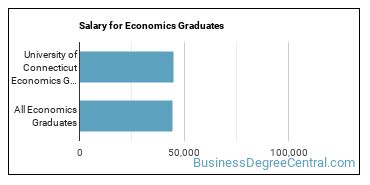
Economics Student Demographics at UCONN
Take a look at the following statistics related to the make-up of the economics majors at University of Connecticut.
UCONN Economics Bachelor’s Program
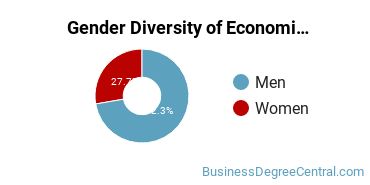
The following table and chart show the race/ethnicity for students who recently graduated from University of Connecticut with a bachelor's in economics.
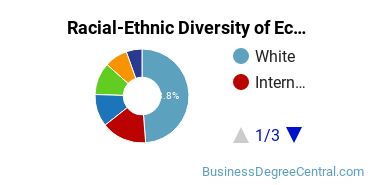
| Race/Ethnicity | Number of Students |
|---|---|
| Asian | 46 |
| Black or African American | 29 |
| Hispanic or Latino | 43 |
| White | 189 |
| International Students | 129 |
| Other Races/Ethnicities | 19 |
UCONN Economics Master’s Program
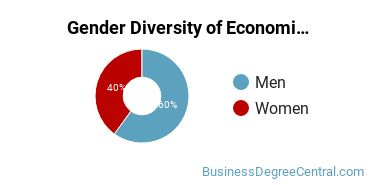
The following table and chart show the race/ethnicity for students who recently graduated from University of Connecticut with a master's in economics.
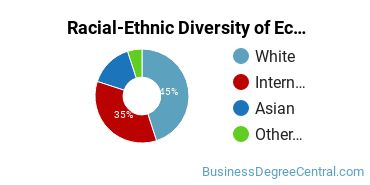
| Race/Ethnicity | Number of Students |
|---|---|
| Asian | 2 |
| Black or African American | 1 |
| Hispanic or Latino | 0 |
| White | 6 |
| International Students | 13 |
| Other Races/Ethnicities | 0 |
UCONN also has a doctoral program available in economics. In 2021, 4 students graduated with a doctor's degree in this field.
Concentrations Within Economics
Economics majors may want to concentrate their studies in one of these areas. The table shows all degrees awarded in this field awarded for all degree levels at University of Connecticut. A concentration may not be available for your level.
| Concentration | Annual Degrees Awarded |
|---|---|
| General Economics | 464 |
| Econometrics & Quantitative Economics | 17 |
Careers That Economics Grads May Go Into
A degree in economics can lead to the following careers. Since job numbers and average salaries can vary by geographic location, we have only included the numbers for CT, the home state for University of Connecticut.
| Occupation | Jobs in CT | Average Salary in CT |
|---|---|---|
| Market Research Analysts and Marketing Specialists | 7,410 | $77,010 |
| Managers | 6,590 | $129,730 |
| Survey Researchers | 310 | $51,740 |
| Economics Professors | 240 | $98,870 |
| Economists | 140 | $95,450 |
References
*The racial-ethnic minorities count is calculated by taking the total number of students and subtracting white students, international students, and students whose race/ethnicity was unknown. This number is then divided by the total number of students at the school to obtain the racial-ethnic minorities percentage.
- College Factual
- National Center for Education Statistics
- O*NET Online
- Image Credit: By Daderot under License
More about our data sources and methodologies.
Featured Schools
You have goals. Southern New Hampshire University can help you get there. Whether you need a bachelor's degree to get into a career or want a master's degree to move up in your current career, SNHU has an online program for you. Find your degree from over 200 online programs.
Visit School
